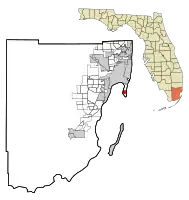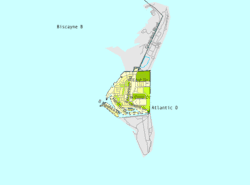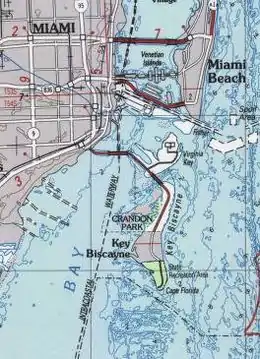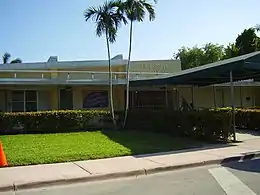Key Biscayne, Florida
Key Biscayne is an island village in Miami-Dade County, Florida, United States. The village is part of the Miami metropolitan area of South Florida. The population was 14,809 at the 2020 census,[2] up from 12,344 in 2010.[5]
Key Biscayne, Florida | |
|---|---|
| Village of Key Biscayne | |
 Seal | |
| Motto: Island Paradise | |
 Location in Miami-Dade County and the state of Florida | |
 U.S. Census Bureau map showing village boundaries | |
| Coordinates: 25°41′25″N 80°9′54″W | |
| Country | |
| State | |
| County | |
| Incorporated | June 18, 1991 |
| Government | |
| • Type | Council-Manager |
| • Mayor | Joe I. Rasco |
| • Vice Mayor | Franklin H. Caplan |
| • Councilmembers | Edward London, Allison McCormick, Brett G. Moss, Oscar Sardiñas, and Fernando A. Vasquez |
| • Village Manager | Steven C. Williamson |
| • Village Clerk | Jocelyn Brewster Koch |
| Area | |
| • Total | 1.71 sq mi (4.42 km2) |
| • Land | 1.25 sq mi (3.23 km2) |
| • Water | 0.46 sq mi (1.19 km2) 8.63% |
| Elevation | 3 ft (1 m) |
| Population | |
| • Total | 14,809 |
| • Density | 11,875.70/sq mi (4,584.30/km2) |
| Time zone | UTC−5 (Eastern (EST)) |
| • Summer (DST) | UTC−4 (EDT) |
| ZIP Code | 33149 |
| Area code(s) | 305, 786, 645 |
| FIPS code | 12-36300[3] |
| GNIS feature ID | 0285075[4] |
| Website | www |

Geography
Key Biscayne lies south of Miami Beach and east of Miami. The village is connected to Miami via the Rickenbacker Causeway, originally built in 1947. Because of its low elevation and direct exposure to the Atlantic Ocean, it is usually among the first Miami areas to be evacuated before an oncoming hurricane.
According to the U.S. Census Bureau, the town has a total area of 1.7 square miles (4.4 km2). 1.2 square miles (3.1 km2) of it are land and 0.5 square miles (1 km2) of it (27.0%) are water.[1] The village is bordered on the north by Crandon Park, a Miami-Dade County park; on the south by Bill Baggs Cape Florida State Park; on the east by the Atlantic Ocean; and on the west by Biscayne Bay.
History

While there had been earlier schemes to develop a town on Key Biscayne, it was not until the opening of the 4-mile-long (6.4 km) Rickenbacker Causeway from Miami to Virginia Key and on to Key Biscayne in 1947 that the island was opened up to large-scale residential development. The northern two-thirds of the island had been operated as the largest coconut plantation in the continental United States during the first half of the 20th century. In 1940 the Matheson family donated over 800 acres (3.2 km2) of their land to Dade County for a public park (Crandon Park) in exchange for a commitment that the county would build a causeway to the island. The remaining Matheson property, stretching across the middle of the island, was then sold off to developers. Starting in 1951, the Mackle Construction Company offered new homes on the island for US$9,540, with just US$500 down. A U.S. Post Office contract branch was opened, the Community Church started holding services in an old coconut-husking shed, and the Key Biscayne Elementary School opened in 1952.[6]
The southern third of Key Biscayne, which included Cape Florida, was owned by James Deering and, after his death, by his brother Charles, for 35 years. In 1948 José Manuel Áleman, a Cuban politician in exile, bought the Cape Florida property from the Deering estate. After Áleman died in 1951, his widow, Elena Santeiro Garcia, added to her Cape Florida property by buying an ocean-to-bay strip that had been part of the Matheson property. This strip included a canal that had been dug by William Matheson in the 1920s, and which extended from the bay across most of the island. The land north of this canal was developed as part of what is now the Village of Key Biscayne. Garcia sold the Cape Florida property in 1966 to the state of Florida. This land became Bill Baggs Cape Florida State Park, which opened January 1, 1967.[7]
U.S. President Richard Nixon purchased the first of his three waterfront homes, forming a compound known as the Florida White House, in 1969 to be close to his close friend and confidant Bebe Rebozo and industrialist Robert Abplanalp (inventor of the modern spray can valve). Bebe Rebozo, owner of the Key Biscayne Bank, was indicted for laundering a $100,000 donation from Howard Hughes to the Nixon election campaign. President Kennedy and Nixon met for the first time after the 1960 election loss by Nixon in an oceanfront villa at the old Key Biscayne Hotel. Plans for the Watergate break-in at Democratic headquarters were discussed at the Key Biscayne Nixon compound and, as the Watergate scandal unfolded, Nixon spent more time in seclusion there. Nixon visited Key Biscayne more than 50 times between 1969 and 1973. The U.S. Department of Defense spent $400,000 constructing a helicopter landing pad in Biscayne Bay adjacent to the Nixon compound, and when Nixon sold his property, including the helicopter pad, there were public accusations that he enriched himself at taxpayer expense.
The area was incorporated as a new municipality in 1991, which made it the first new city in Miami-Dade County in over fifty years. Rafael Conte was elected the first mayor along with members of the founding Village Council including Clifford Brody, Mortimer Fried, Michael Hill, Bautista Tedin, Lucas Keller, Luis Lauredo, Joe Rasco, and Raymond Sullivan. The municipality's first manager was C. Samuel Kissinger and the first clerk was Guido Inguanzo. The incorporation of the village, which was overseen by Alfred Brewer, provided local control over taxes and future development.
Key Biscayne is a small, intimate community. The majority of families that live there have known each other for generations. The children who grew up on the island are known as "Key Rats".[8]
In 1992, Hurricane Andrew flooded some homes and businesses on Key Biscayne, impacting insurance.[9] The eye wall passed over uninhabited Bill Baggs Cape Florida State Park which received the brunt of the storm. The storm damage was a blessing for the park because it destroyed all the non-native vegetation that the state had been trying to eradicate. Federal and state funding allowed the replanting with native vegetation, making the park a showplace natural area. The town is in Evacuation Zone A.[10] A 2017 study found that the town could be partly flooded at high tides by 2045 after sea-level rise.[11] Property values fell. In November 2020, the town voted to approve a $100 million bond to protect itself.[12]
The village has its own fire, police and public elementary and middle school. The millage tax rate remains one of the lowest of any municipality in Miami-Dade County. In 2004, the village completed the construction of a civic center including fire, police and administration buildings and a recreation and community center with indoor multi use courts, outdoor swimming pool and a renowned musical theater program.
Climate
Key Biscayne has a tropical monsoon climate (Am). Key Biscayne experiences hot, humid summers and warm, dry winters. The island is in USDA plant zone 11a. Due to its island location, Key Biscayne is subject to cooler highs than Miami year-round. Hurricanes threaten the island occasionally, though landfalls are rare. Precipitation is lower than that of Miami, as the Atlantic Ocean inhibits summer thunderstorm convection.
| Climate data for Cape Florida (1991–2020 normals, extremes 1999–present) | |||||||||||||
|---|---|---|---|---|---|---|---|---|---|---|---|---|---|
| Month | Jan | Feb | Mar | Apr | May | Jun | Jul | Aug | Sep | Oct | Nov | Dec | Year |
| Record high °F (°C) | 87 (31) |
87 (31) |
90 (32) |
96 (36) |
93 (34) |
96 (36) |
96 (36) |
96 (36) |
95 (35) |
93 (34) |
90 (32) |
88 (31) |
96 (36) |
| Mean maximum °F (°C) | 83.3 (28.5) |
83.3 (28.5) |
85.9 (29.9) |
88.7 (31.5) |
88.9 (31.6) |
92.0 (33.3) |
92.6 (33.7) |
92.4 (33.6) |
92.1 (33.4) |
90.5 (32.5) |
86.5 (30.3) |
84.3 (29.1) |
93.9 (34.4) |
| Average high °F (°C) | 77.5 (25.3) |
78.9 (26.1) |
80.9 (27.2) |
83.8 (28.8) |
86.5 (30.3) |
89.6 (32.0) |
90.8 (32.7) |
91.4 (33.0) |
90.3 (32.4) |
87.2 (30.7) |
82.7 (28.2) |
79.7 (26.5) |
84.9 (29.4) |
| Daily mean °F (°C) | 70.1 (21.2) |
71.8 (22.1) |
74.0 (23.3) |
77.6 (25.3) |
80.7 (27.1) |
83.8 (28.8) |
84.9 (29.4) |
85.4 (29.7) |
84.5 (29.2) |
81.6 (27.6) |
76.7 (24.8) |
72.9 (22.7) |
78.7 (25.9) |
| Average low °F (°C) | 62.8 (17.1) |
64.8 (18.2) |
67.1 (19.5) |
71.5 (21.9) |
74.9 (23.8) |
78.0 (25.6) |
79.0 (26.1) |
79.4 (26.3) |
78.7 (25.9) |
76.1 (24.5) |
70.7 (21.5) |
66.0 (18.9) |
72.4 (22.4) |
| Mean minimum °F (°C) | 44.5 (6.9) |
48.1 (8.9) |
52.6 (11.4) |
60.2 (15.7) |
67.0 (19.4) |
71.9 (22.2) |
73.9 (23.3) |
74.4 (23.6) |
74.0 (23.3) |
65.2 (18.4) |
56.3 (13.5) |
50.7 (10.4) |
41.7 (5.4) |
| Record low °F (°C) | 35 (2) |
38 (3) |
44 (7) |
49 (9) |
61 (16) |
64 (18) |
71 (22) |
71 (22) |
66 (19) |
54 (12) |
45 (7) |
37 (3) |
35 (2) |
| Average precipitation inches (mm) | 2.44 (62) |
2.00 (51) |
2.37 (60) |
3.17 (81) |
5.67 (144) |
7.37 (187) |
5.64 (143) |
7.05 (179) |
7.54 (192) |
6.33 (161) |
3.51 (89) |
2.24 (57) |
55.33 (1,406) |
| Average precipitation days (≥ 0.01 in) | 7.9 | 6.5 | 6.3 | 6.1 | 9.9 | 14.8 | 14.9 | 15.8 | 15.3 | 12.8 | 9.0 | 8.0 | 127.3 |
| Source: NOAA (mean maxima/minima 2006–2020)[13][14] | |||||||||||||
Demographics

| Census | Pop. | Note | %± |
|---|---|---|---|
| 2000 | 10,507 | — | |
| 2010 | 12,344 | 17.5% | |
| 2020 | 14,809 | 20.0% | |
| U.S. Decennial Census[15] | |||
2020 census
| Race | Number | Percentage |
|---|---|---|
| White (NH) | 3,979 | 26.87% |
| Black or African American (NH) | 27 | 0.18% |
| Native American or Alaska Native (NH) | 3 | 0.02% |
| Asian (NH) | 106 | 0.72% |
| Pacific Islander or Native Hawaiian (NH) | 0 | 0.00% |
| Some other race (NH) | 87 | 0.59% |
| Two or more races/Multiracial (NH) | 719 | 4.86% |
| Hispanic or Latino (any race) | 9,888 | 66.77% |
| Total | 14,809 |
As of the 2020 U.S. census, there were 14,809 people, 4,058 households, and 3,174 families residing in the village.[17]
2010 census
| Key Biscayne Demographics | |||
|---|---|---|---|
| 2010 census | Key Biscayne | Miami-Dade County | Florida |
| Total population | 12,344 | 2,496,435 | 18,801,310 |
| Population, percent change, 2000 to 2010 | +17.5% | +10.8% | +17.6% |
| Population density | 10,070.7/sq mi | 1,315.5/sq mi | 350.6/sq mi |
| White or Caucasian (including White Hispanic) | 96.2% | 73.8% | 75.0% |
| (Non-Hispanic White or Caucasian) | 36.5% | 15.4% | 57.9% |
| Black or African-American | 0.4% | 18.9% | 16.0% |
| Hispanic or Latino (of any race) | 61.6% | 65.0% | 22.5% |
| Asian | 1.1% | 1.5% | 2.4% |
| Native American or Native Alaskan | 0.1% | 0.2% | 0.4% |
| Pacific Islander or Native Hawaiian | 0.0% | 0.0% | 0.1% |
| Two or more races (Multiracial) | 1.2% | 2.4% | 2.5% |
| Some Other Race | 1.0% | 3.2% | 3.6% |
As of the 2010 U.S. census, there were 12,344 people, 4,256 households, and 2,976 families residing in the village.[18]
2000 census
In 2000, 32.3% had children under the age of 18 living with them, 58.0% were married couples living together, 7.7% had a female householder with no husband present, and 31.9% were non-families. 27.9% of all households were made up of individuals, and 9.5% had someone living alone who was 65 years of age or older. The average household size was 2.47 and the average family size was 2.99.
In 2000, the village population was spread out, with 24.2% under the age of 18, 4.6% from 18 to 24, 29.6% from 25 to 44, 26.0% from 45 to 64, and 15.6% who were 65 years of age or older. The median age was 40 years. For every 100 females, there were 88.4 males. For every 100 females age 18 and over, there were 84.8 males.
In 2000, the median income for a household in the village was $86,599, and the median income for a family was $107,610. Males had a median income of $86,322 versus $46,765 for females. The per capita income for the village was $54,213.
As of 2000, speakers of Spanish as a first language accounted 59.73% of residents, while English made up 30.84%, Portuguese was at 2.83%, French at 2.67%, Italian consisted of 1.67%, and German was the mother tongue of 1.47% of the population.[19]
Media
The Islander News is a weekly community newspaper serving Key Biscayne. The estimated circulation in 2020 was 3,600.[20][21]
Key Biscayne Magazine is a lifestyle magazine published in Miami by TAG Media, publishers of Brickell Magazine. The circulation of the magazine was about 10,000 in 2020.[22][23]
Education

Miami-Dade County Public Schools serves Key Biscayne. The Key Biscayne K–8 Center serves Key Biscayne.[24][25] Middle school students may attend Ponce de Leon Middle School in Coral Gables instead of the Key Biscayne School.[26] High school students are zoned to Coral Gables Senior High School.[27][28]
MAST Academy, a magnet school on Virginia Key, has since 2012 given eligible Key Biscayne residents priority in filling 1,100 seats in the school's Cambridge program.[28][29]
The Miami-Dade Public Library System operates the 6,000-square-foot (560 m2) Key Biscayne Branch Library. It opened in January 1985.[30]
St. Agnes Academy is a Catholic private school on the island located at 122 Harbor Drive, of the Roman Catholic Archdiocese of Miami. It serves pre-K–8th grade.
Notable people
- Jaime Bayly, writer
- Jay Berger (born 1966), tennis player; highest world ranking # 7
- Raul Boesel, race car driver
- Cher, actress and singer[31]
- Soman Chainani, writer
- Gaetano Ciancio, transplant surgeon
- Isabel Pérez Farfante, carcinologist
- Mary Joe Fernández, tennis star
- Timothy Ferris, author, went to Key Biscayne Elementary School
- Emerson Fittipaldi, ex-F1 and Indianapolis 500 winner, Indycar driver[32]
- Fonseca, Colombian singer
- Andy García, actor[33]
- Arthur Hanlon, pianist[34]
- Juanes, Colombian singer
- Luis Lauredo, village councilman and former U.S. Ambassador to the Organization of American States[35][36]
- Martin Margulies, billionaire art collector and fixture of Miami's high society[37]
- Juan Pablo Montoya, Colombian race car driver
- Richard Nixon, U.S. president; see Nixon's Florida White House[38]
- Brad Pitt, actor; once owned a home in Key Biscayne
- "Bebe" Rebozo, banker and confidante of Richard Nixon[39]
- Eddie Rickenbacker, fighter pilot, and his wife Adelaide
Hotels and condominiums controversy
As noted above, the construction of several condominium complexes in Key Biscayne caused the population to soar. In 2007, voters approved an amendment to the village charter requiring that future land use changes be approved by voters. In 2008, the village council, saying that requiring community voting on zoning changes infringed on its responsibility, submitted another proposal to revise the charter. But on November 4, 2008, voters overwhelmingly rejected the council's proposed change, defeating the amendment by a more than two-to-one margin.[40][41]
Other information
Key Biscayne hosts the Tennis Center at Crandon Park, former home to the Miami Open Tennis Tournament, and a golf course, along with many amenities for water sports and fishing.
Key Biscayne has a visitors center, open 24/7, 365 days a year, located in the Village Hall, 88 West McIntyre Street #100, adjacent to the Police Station. Staffed M–F from 9am to 5pm
Gallery
 Fire station
Fire station
References
- "2022 U.S. Gazetteer Files: Florida". United States Census Bureau. Retrieved January 3, 2023.
- "P1. Race – Key Biscayne village, Florida: 2020 DEC Redistricting Data (PL 94-171)". U.S. Census Bureau. Retrieved January 3, 2023.
- "U.S. Census website". United States Census Bureau. Retrieved January 31, 2008.
- "US Board on Geographic Names". United States Geological Survey. October 25, 2007. Retrieved January 31, 2008.
- "P1. Race – Biscayne village, Florida: 2010 DEC Redistricting Data (PL 94-171)". U.S. Census Bureau. Retrieved January 3, 2023.
- Blank. pp. 159-162.
- Blank. pp.166-171.
- "Tale of a Key Rat: The Michael Capponi story". The Miami Herald.
- Adrian Sainz (August 24, 2002). "Ten years after Hurricane Andrew, effects are still felt". South Florida Sun-Sentinel. Miami, Florida. Associated Press. Archived from the original on October 14, 2012. Retrieved May 8, 2012.
- "Flood Information and Protection". keybiscayne.fl.gov. Archived from the original on November 4, 2020.
- "Village of Key Biscayne final vulnerability assessment" (PDF). 2017. Archived from the original (PDF) on November 4, 2020.
by 2045, if no adaptation steps are taken, most roads within the village will experience tidal flooding during king tides, as will many low-lying residential and commercial properties.
- Harris, Alex (November 3, 2020). "Key Biscayne votes to spend $100 million to protect itself from sea-level rise". Miami Herald. Archived from the original on November 4, 2020.
- "NOWData – NOAA Online Weather Data". National Oceanic and Atmospheric Administration. Retrieved February 20, 2023.
- "Summary of Monthly Normals 1991-2020". National Oceanic and Atmospheric Administration. Retrieved February 20, 2023.
- "Census of Population and Housing". Census.gov. Retrieved June 4, 2015.
- "Explore Census Data". data.census.gov. Retrieved February 9, 2022.
- "S1101 HOUSEHOLDS AND FAMILIES - 2020: Key Biscayne city, Florida". United States Census Bureau.
- "S1101 HOUSEHOLDS AND FAMILIES - 2010: Key Biscayne city, Florida". United States Census Bureau.
- "MLA Data Center Results of Key Biscayne, FL". Modern Language Association. Retrieved November 1, 2007.
- "Key Biscayne Islander News". Mondotimes. 2021. Retrieved August 7, 2021.
- "About Us". Islander Media Group. 2021. Retrieved August 7, 2021.
- "About Us". Magazine Key Biscayne. Retrieved August 7, 2021.
- "Key Biscayne Advertising – Magazine Advertising Costs". Resources for Entrepreneurs. 2021.
- "Key Biscayne K-8 Center". keybiscayne.dadeschools.net. Retrieved June 13, 2018.
- "KEY BISCAYNE K-8 CENTER School Legal Boundaries Description." Miami-Dade County Public Schools. Retrieved on April 25, 2013.
- "PONCE DE LEON MS School Legal Boundaries Description." Miami-Dade County Public Schools. Retrieved on April 25, 2013.
- "Coral Gables SHS School Legal Boundaries Description." Miami-Dade County Public Schools. Retrieved on April 25, 2013.
- "MAST Academy about to be expanded for Key Biscayne students." Miami Herald. June 13, 2013. Retrieved on April 26, 2013.
- Josephson, Kelly (May 12, 2017). "School district adds 22 6th-grade seats at MAST Academy". The Islander News. Retrieved February 26, 2019.
- "Key Biscayne Branch." Miami-Dade Public Library System. Retrieved on April 27, 2013.
- "THE CHER HOUSE". Key Biscayne Magazine. July 13, 2018. Retrieved December 13, 2019.
- Cubilla, Rachel (November 29, 2018). "Fittipaldi Family". Key Biscayne Magazine. Retrieved December 13, 2019.
- Wadler, Joyce (April 27, 2006). "The Soul of Havana on Biscayne Bay". The New York Times. ISSN 0362-4331. Retrieved December 13, 2019.
- Coffee, Rod. "Key Biscayne music man headlines Coconut Grove's festival this weekend". IslanderNews.com. Retrieved December 13, 2019.
- "Village of Key Biscayne, FL". keybiscayne.fl.gov. Retrieved May 15, 2022.
- "Council of American Ambassadors". Council of American Ambassadors. Retrieved May 15, 2022.
- Pogrebin, Robin (December 6, 2015). "In a Red-Hot Art Market, the Collector Martin Margulies Stays Cool". The New York Times. ISSN 0362-4331. Retrieved December 13, 2019.
- "Nixon presidential retreat in Key Biscayne torn down". Sarasota Herald-Tribune. Associated Press. Retrieved December 13, 2019.
- Pearson, Richard (May 10, 1998). "Charles 'Bebe' Rebozo, 85, Dies". www.washingtonpost.com. Archived from the original on August 19, 2000. Retrieved December 13, 2019.
- Key Biscayne Ordinance setting referendum Archived July 21, 2011, at the Wayback Machine Retrieved 2008-11-01
- The Miami Herald, 2008-11-05
Further reading
- Curtiss, Muriel (1989). "Key Biscayne – An isle of palms" (PDF). South Florida History Magazine. No. 1. pp. 6–9 – via HistoryMiami.
